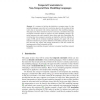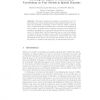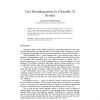1342 search results - page 29 / 269 » Measuring concept relatedness using language models |
ER
2008
Springer
13 years 11 months ago
2008
Springer
It is common to find that the definition or common usage of a data modelling language causes there to be restrictions placed on the evolution of data values that are associated wit...
UM
2009
Springer
14 years 4 months ago
2009
Springer
Abstract. This paper examines the problem of uncertainty due to instrumentation in user modeling systems within spatial domains. We consider the uncertainty of inferring a user’s...
MATA
2000
Springer
14 years 1 months ago
2000
Springer
In order to model telecommunications services as mobile agent system, we are defining a methodology based on the RM-ODP standards. Our approach makes the distinction between the se...
AGI
2008
13 years 11 months ago
2008
The structure of possible text understanding system is discussed. To store concepts and knowledge system uses multilayer ontology based on pragmatic memory model. The way of knowle...
APSEC
2000
IEEE
14 years 2 months ago
2000
IEEE
It has been recognised that formal methods are useful as a modelling tool in requirements engineering. Specification languages such as Z permit the precise and unambiguous modell...



